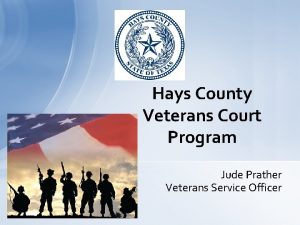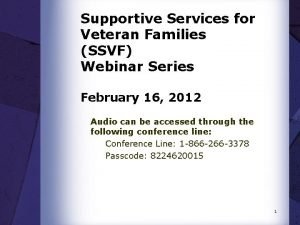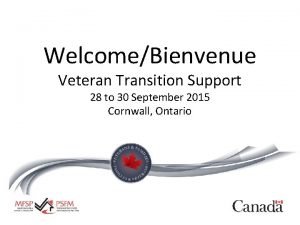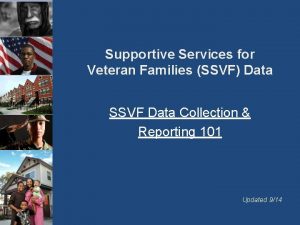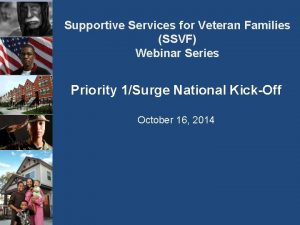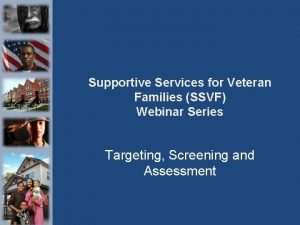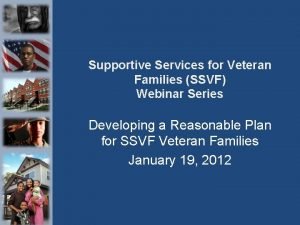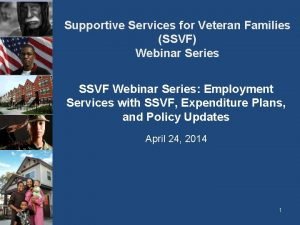Supportive Services for Veteran Families SSVF PROGRESSIVE ENGAGEMENT









- Slides: 9

Supportive Services for Veteran Families (SSVF) PROGRESSIVE ENGAGEMENT Jennifer Colbert, LCSW SSVF Regional Coordinator Kenneth Mueller, MBA, LCSW, CAP Orlando VAMC Homeless Program Manager

What is Progressive Engagement • Progressive Engagement is an approach to helping households end their homelessness as rapidly as possible, despite barriers, with minimal financial and support resources. More supports are offered to those households who struggle to stabilize and cannot maintain their housing without assistance. • Programs who successfully utilize progressive engagement are regularly re-assessing housing barriers. • They seek to close cases as soon as housing retention barriers are resolved.

What is Progressive Engagement • Progressive engagement means supports are increased only when there is evidence that the program participant is going to need greater assistance on any particular element of their life our housing stability. While intensity can increase, it should also decrease as the person begins to exercise greater independence and personal advocacy. CRISIS RESPONSE PROGRESSIVE ENGAGEMENT CASE MANAGEMENT Org Code, 2015

SSVF Program Guidance • The intentional use of SSVF as a transitional subsidy while awaiting final HUD-VASH enrollment is not allowable and is inconsistent with PL-110 -387 which created SSVF and 38 CFR 62 which govern its operations. VA funds major national initiatives through the Grant and Per Diem (GPD) and Health Care for Homeless Veterans (HCHV) Contract Residential Services to meet the needs of Veterans who need transitional housing services. When transitional or temporary housing is needed, staff is expected to work with available GPD and HCHV resources. SSVF cannot be used as a planned, transitional housing intervention with the intention of bridging HUD-VASH participants awaiting vouchers or the completion of housing inspections or other administrative needs. SSVF grantees should not house a Veteran with the sole intention of transitioning that Veteran to a HUD-VASH subsidy. • There are two important exceptions when SSVF resources may be used as a transition into HUD-VASH. 1. 2. It is acceptable for Veterans to be housed with SSVF assistance and then be transferred to HUD-VASH as part of a progressive engagement approach, but in these situations the initial intent was to permanently house Veterans using SSVF. Progressive engagement is a strategy to enable service delivery systems to effectively target resources by starting with a small amount of assistance and then adding more assistance as needed. In progressive engagement, every effort is made by SSVF to support a successful tenancy with SSVF alone; the decision to use HUD-VASH is based on reassessment that occurs after SSVF enrollment and a progressive set of support has been offered or exhausted, and where that assessment demonstrates that SSVF resources will not be sufficient for the Veteran to maintain the tenancy without permanent supportive housing. It is critically important to raise the potential need for HUD-VASH with your local HUD-VASH team as soon as it becomes apparent that this level of assistance may be necessary. It will take time for HUD-VASH to assess the household’s eligibility and further must determine whether a voucher will be available. See HUD FAQ 530 for restrictions and information related to eligibility across RRH and PSH projects. These situations should be rare and, where possible, only occur within the context of the local community’s Prioritization policies. In the event suitable transitional housing is unavailable through GPD, HCHV or community resources while awaiting permanent housing placement, a Veteran household may be enrolled in SSVF to utilize authority available under 38 CFR 62. 34(f).

Rationale • Avoids false assumptions: people who are very poor and may be disabled – including those who score high on assessment tools – do not all need or want more intensive or longer-term assistance. People who initially appear to need more may end up needing less – and vis-versa. • Individualization: when a participant shows s/he needs more help, more help can be provided. Programs should offer the right amount of assistance for the right amount of time to meet individual needs. • Efficiency: by avoiding more assistance than is required to end homelessness and prevent an immediate return to streets or shelter, programs can help more people, close housing placement gaps, and reduce the time people remain homeless. • Effectiveness: rapid re-housing programs that use Progressive Engagement show high rates of success serving people with a wide range of needs. Programs take risks, frequently have to make tough decisions, and assume some will fail – meaning the program may need to do something different if they help the same participant again.

Keys to Success • Flexible resources (money and staff). • Relationships with landlords. • Links to other services in the community. • Skill managing a flexible program. • Partnership with clients to make a realistic plan. • Messaging to clients, landlords, partners. (USICH) 2015

Keys To Success • Targeting • Baseline Assessment & Initial Housing Plan • Individualized, Flexible Assistance • Housing and Service Partnerships • Case Closure • Program Policies, Procedures, and Quality Improvement

Examples from the Field • What interventions do you feel would be useful prior to referring to a higher level of care? • What misconceptions have you seen with progressive engagement? • Do you have an example of a case where you had to utilize this intervention successfully? • What made it different? How did you decide? • How does this model fit in your CES?

 Hays county district clerk
Hays county district clerk Ssvf legal services
Ssvf legal services Big families vs small families
Big families vs small families 15 things every veteran wants you to know
15 things every veteran wants you to know Veteran transition academy
Veteran transition academy Goldman sachs veterans integration program
Goldman sachs veterans integration program Veteran market segmentation
Veteran market segmentation Veterans employment opportunity act
Veterans employment opportunity act Disabled hoosier veteran license plate
Disabled hoosier veteran license plate Winslow homer veteran in a new field
Winslow homer veteran in a new field
